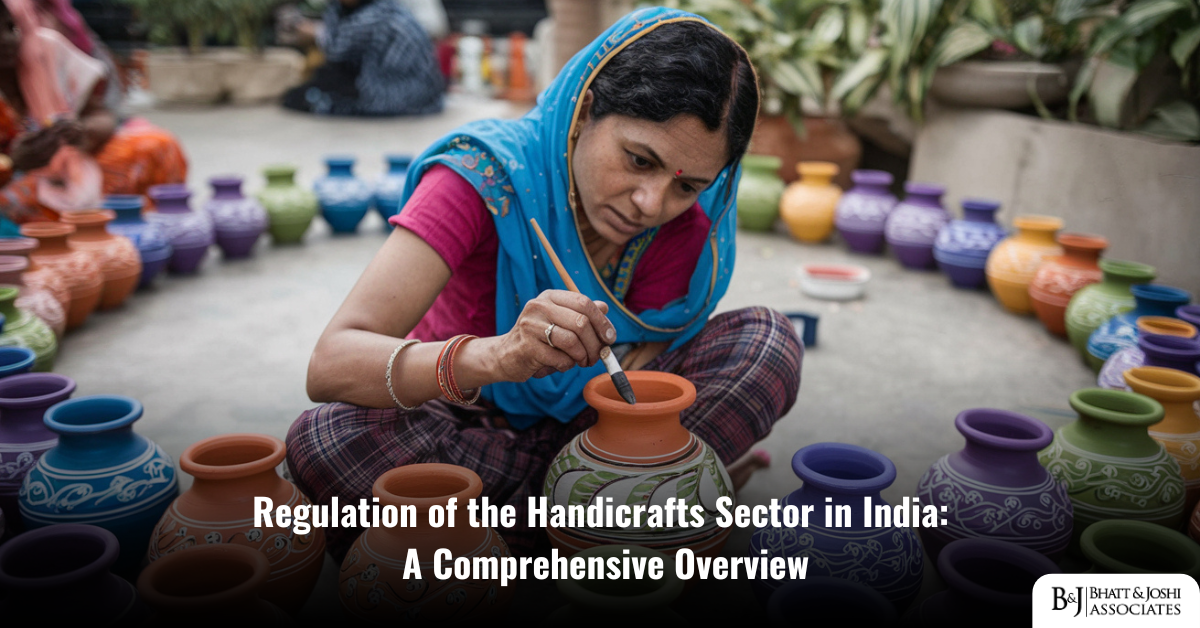Introduction
The handicrafts sector in India is not just an important source of livelihood for millions of artisans but also a living repository of the country’s rich cultural heritage. This sector plays a crucial role in India’s economy, contributing significantly to export earnings and providing large-scale employment, especially in rural and semi-urban areas. This document provides an in-depth exploration of the regulatory framework, laws, and significant case laws governing the handicrafts sector in India.
Regulatory Body: Office of the Development Commissioner for Handicrafts
The primary regulatory authority for the handicrafts sector is the Office of the Development Commissioner (DC) for Handicrafts, operating under the Ministry of Textiles, Government of India. Established in 1950, this office is responsible for the promotion and development of handicrafts and handcrafted products.
Functions and Responsibilities
The Development Commissioner for Handicrafts oversees various aspects of the industry, including:
- Formulation and implementation of policies for handicrafts development
- Coordination with state governments and other agencies
- Implementation of various developmental and welfare schemes
- Promotion of handicraft products in domestic and international markets
- Research and development initiatives
- Skill development and training programs for artisans
- Preservation of endangered crafts
Legal Framework Governing Handicrafts Sector in India
Unlike some other sectors, the handicrafts industry in India does not have a single, comprehensive legislation governing it. Instead, it is regulated through a combination of policies, schemes, and laws that address various aspects of the sector.
Geographical Indications of Goods (Registration and Protection) Act, 1999
This Act plays a crucial role in protecting traditional handicrafts and other products with a specific geographical origin. Key provisions include:
- Section 2(e) defines “geographical indication” as: “An indication which identifies such goods as agricultural goods, natural goods or manufactured goods as originating, or manufactured in the territory of a country, or a region or locality in that territory, where a given quality, reputation or other characteristic of such goods is essentially attributable to its geographical origin and in case where such goods are manufactured goods one of the activities of either the production or of processing or preparation of the goods concerned takes place in such territory, region or locality, as the case may be.”
- Section 8 outlines the registration process for geographical indications.
- Section 20 describes the rights conferred by registration: “Subject to the other provisions of this Act, the registration of a geographical indication shall, if valid, give,— (a) to the registered proprietor of the geographical indication and the authorised user or users thereof the right to obtain relief in respect of infringement of the geographical indication in the manner provided by this Act; (b) to the authorised user thereof the exclusive right to the use of the geographical indication in relation to the goods in respect of which the geographical indication is registered.”
This Act has been instrumental in protecting traditional handicrafts like Madhubani paintings, Kancheepuram silk, and Darjeeling tea.
The Micro, Small and Medium Enterprises Development Act, 2006
While not specific to handicrafts, this Act provides a framework for the promotion and development of micro, small and medium enterprises, which include many handicraft units. Key provisions include:
- Definition of micro, small, and medium enterprises
- Establishment of the Micro and Small Enterprises Facilitation Council
- Measures to facilitate promotion and development of MSMEs
The Designs Act, 2000
This Act provides for the protection of new or original designs applied to articles. It is particularly relevant for handicrafts as it helps protect unique designs created by artisans. Key features include:
- Registration of designs
- Rights conferred by registration
- Duration of protection (initially 10 years, extendable by 5 years)
Key Case Laws Shaping Handicrafts Sector in India
Several significant court judgments have shaped the interpretation and implementation of regulations affecting the handicrafts sector in India.
Darjeeling Planters Association v. The Tea Board (2011)
While this case primarily dealt with tea, it had significant implications for geographical indications in general, including handicrafts. The Calcutta High Court observed:
“The Geographical Indications of Goods (Registration and Protection) Act, 1999 provides a much-needed legal framework for the protection of geographical indications in India. It not only protects the interests of producers but also benefits consumers by providing an assurance of quality and distinctiveness of the products.”
This judgment reinforced the importance of protecting traditional handicrafts and other products with geographical significance.
Nani Palkhivala Foundation v. Registrar of Geographical Indications (2012)
This case dealt with the registration of ‘Koyyalagudem Kalamkari’ as a geographical indication. The Intellectual Property Appellate Board (IPAB) emphasized the need for a clear link between the product and its geographical origin:
“For a handicraft to be registered as a geographical indication, there must be a clear and demonstrable link between the characteristics of the product and its place of origin. This link should be more than merely historical or reputational.”
This decision has significant implications for the registration of handicrafts as geographical indications, setting a high standard for establishing the connection between a craft and its place of origin.
Craft Development Institute v. Registrar of Geographical Indications (2015)
This case involved the registration of ‘Kashmiri Pashmina’ as a geographical indication. The IPAB ruled:
“The collective nature of traditional knowledge and skills involved in handicraft production must be recognized in the process of geographical indication registration. The rights and interests of the entire community of artisans must be protected, not just those of a single organization or group.”
This judgment highlighted the importance of community rights in the context of traditional handicrafts and geographical indications.
Recent Developments and Initiatives
The regulatory landscape of the handicrafts sector continues to evolve, with several recent initiatives aimed at addressing contemporary challenges and opportunities.
National Handicraft Development Programme (NHDP)
Launched in 2017, this comprehensive program aims to develop and promote Indian handicrafts. Key components include:
- Ambedkar Hastshilp Vikas Yojana (AHVY) for integrated development of handicraft clusters
- Design and Technology Upgradation Scheme
- Marketing Support and Services Scheme
- Research and Development Scheme
- Human Resource Development Scheme
Handicrafts and Carpet Sector Skill Council (HCSSC)
Established under the National Skill Development Corporation (NSDC), the HCSSC aims to:
- Develop occupational standards and qualification packs for various handicraft skills
- Conduct skill gap studies and assess training needs
- Accredit training providers and assess and certify trainees
GI-Tagged Handicrafts
The government has been actively promoting the registration of handicrafts under the Geographical Indications of Goods Act. Some notable GI-tagged handicrafts include:
- Madhubani Paintings (Bihar)
- Channapatna Toys and Dolls (Karnataka)
- Makrana Marble (Rajasthan)
- Kangra Tea (Himachal Pradesh)
- Pochampally Ikat (Telangana)
E-Commerce Initiatives
The government has partnered with e-commerce platforms to promote the online sale of handicrafts. Initiatives include:
- Collaboration with Amazon for the “Karigar” program
- Partnership with Flipkart for the “Samarth” initiative
- Development of the Government e-Marketplace (GeM) portal for direct sales to government departments
Challenges and Future Outlook of Handicrafts Sector in India
Despite the supportive regulatory framework and various initiatives, the handicrafts sector faces several challenges:
- Lack of access to credit and working capital
- Competition from machine-made and imported products
- Limited market access, especially for rural artisans
- Inadequate protection of intellectual property rights
- Shortage of raw materials and rising input costs
- Declining interest among younger generations in traditional crafts
To address these challenges, future regulatory efforts may focus on:
- Strengthening the implementation of existing laws and policies
- Enhancing the integration of technology in handicraft production and marketing
- Developing more robust mechanisms for quality control and certification
- Expanding international market access through trade agreements and promotions
- Introducing more comprehensive social security measures for artisans
- Promoting sustainable and eco-friendly practices in handicraft production
Conclusion: Shaping the Future of India’s Handicrafts Sector
The regulatory framework governing India’s handicrafts sector reflects a multifaceted approach to preserving traditional skills while promoting economic growth. From the Geographical Indications of Goods Act to recent initiatives like the National Handicraft Development Programme, the legal and policy landscape demonstrates a commitment to protecting and promoting this vital sector.
As India continues to navigate the challenges of globalization and changing consumer preferences, the regulatory approach to the handicrafts sector will likely need further refinement. The key lies in striking a balance between preserving the authenticity and cultural significance of handicrafts while embracing innovations that can enhance their market appeal and economic viability.
The future of handicraft regulation in India will depend on the effective implementation of existing laws, continuous dialogue between stakeholders, and a willingness to adapt policies to address emerging challenges. By fostering an environment that values both tradition and innovation, India can ensure that its handicrafts sector not only survives but thrives in the global marketplace, continuing to showcase the country’s rich cultural heritage to the world.














